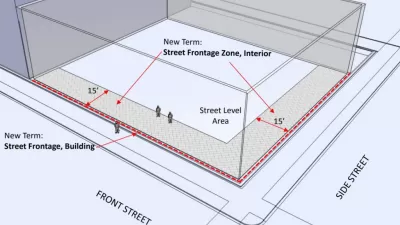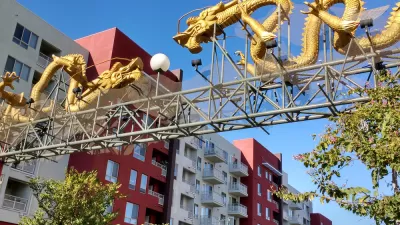The multifamily industry is building more in walkable locations, but developers still need instruction on the manners of placemaking. Here are some hints.
On Monday, I reported that many more multifamily units are being built on street grids, which offer important amenities to residents. Instead of density attached to a congested arterial road, urban apartments are connected to culture and walkable to shops, parks, and schools.
As the multifamily industry strides forward, challenges arise. Some developers have mastered the craft of building in an urban place and using active frontages. Others are merely plunking down buildings with little change in design from those that previously fronted parking lots.
Most communities still have conventional codes that are oblivious to the things that provide comfort to people on foot or bicycle — outside of their one-ton, four-wheel appendage. These elements include awnings and galleries, active building frontages, buildings that shape the public realm into an “outdoor room,” streetscape elements that provide enclosure and protection, and the screening of parking from the view of people on the street. Form-based codes, on the other hand, pay a lot of attention to these aspects of the public realm that improve livability.
FULL STORY: Making multifamily truly urban

Planetizen Federal Action Tracker
A weekly monitor of how Trump’s orders and actions are impacting planners and planning in America.

Map: Where Senate Republicans Want to Sell Your Public Lands
For public land advocates, the Senate Republicans’ proposal to sell millions of acres of public land in the West is “the biggest fight of their careers.”

Restaurant Patios Were a Pandemic Win — Why Were They so Hard to Keep?
Social distancing requirements and changes in travel patterns prompted cities to pilot new uses for street and sidewalk space. Then it got complicated.

Platform Pilsner: Vancouver Transit Agency Releases... a Beer?
TransLink will receive a portion of every sale of the four-pack.

Toronto Weighs Cheaper Transit, Parking Hikes for Major Events
Special event rates would take effect during large festivals, sports games and concerts to ‘discourage driving, manage congestion and free up space for transit.”

Berlin to Consider Car-Free Zone Larger Than Manhattan
The area bound by the 22-mile Ringbahn would still allow 12 uses of a private automobile per year per person, and several other exemptions.
Urban Design for Planners 1: Software Tools
This six-course series explores essential urban design concepts using open source software and equips planners with the tools they need to participate fully in the urban design process.
Planning for Universal Design
Learn the tools for implementing Universal Design in planning regulations.
Heyer Gruel & Associates PA
JM Goldson LLC
Custer County Colorado
City of Camden Redevelopment Agency
City of Astoria
Transportation Research & Education Center (TREC) at Portland State University
Camden Redevelopment Agency
City of Claremont
Municipality of Princeton (NJ)





























